Make sure to watch the video for this recipe! This is my take on a favorite soba dish I ate weekly here in Tokyo, this past fall. The video takes you on a journey from the restaurant, to the supermarket, and finally, to my kitchen, where I attempt to recreate this delicious bowl of soba noodles topped with a gooey and eggy sauce.
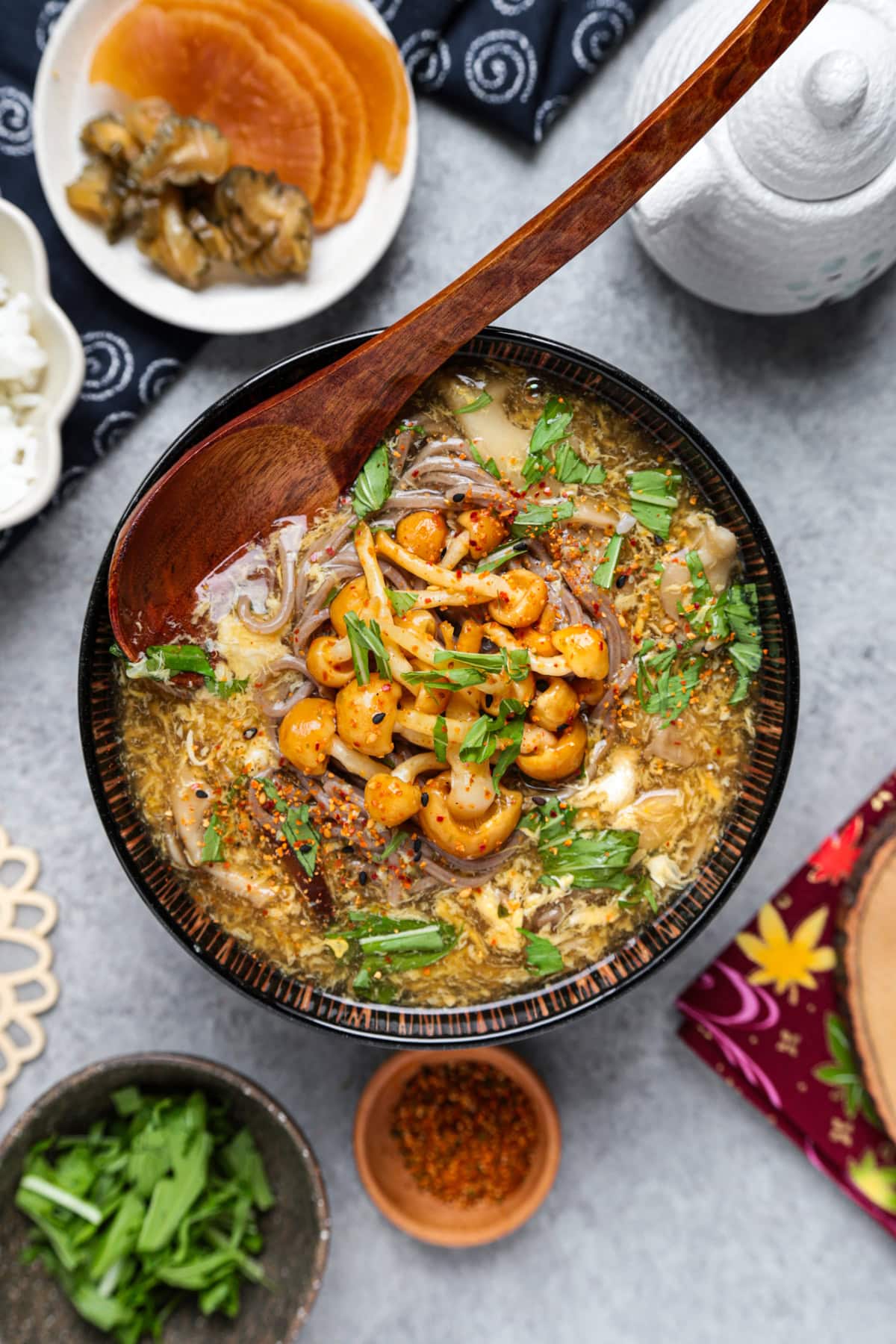
I wanted to try something different with this recipe and blog post. This year I told myself that I wanted my job as a food blogger to be more fun and creative. After all, I have published over 1,000 recipes and have been at it for 13 years, so work can get a bit boring at times and feel uninspiring. But since moving back to Japan 8 months ago I find myself feeling much more excited about food, and wanting to share recipes that are unique to this beautiful country.
One of the many things I love about Japan is how deeply they embrace seasonal ingredients and create dishes that are only available for a few months, before they are taken off the menu. Of course, it can be frustrating when you find something you love very much, but it’s also a reminder that nothing in life is permanent. And that philosophy is applied in everyday life and has changed the way I live my own life, in the best possible way. If you want something, go for it now because it may not be there tomorrow – just like this bowl of soba noodles!
When I first ate this soba dish back in October I couldn’t believe how delicious it was. The flavors and colors of autumn were omnipresent – savory and umami packed broth, earthy maitake mushrooms, red and orange leaf shaped fu, and thin threads of egg to represent the golden colors of fall. Since I knew I only had a month or two to enjoy this dish, I asked myself “can I make this at home?”, which prompted me to create a video and post about it. And the answer to the question is yes – I can make it at home and so can you!
Table of contents
intro
Watch The Video Here!
Watch as I make my way through the street of Tokyo on a beautiful fall day, eating soba, shopping for ingredients, and cooking this delightful dish at home.
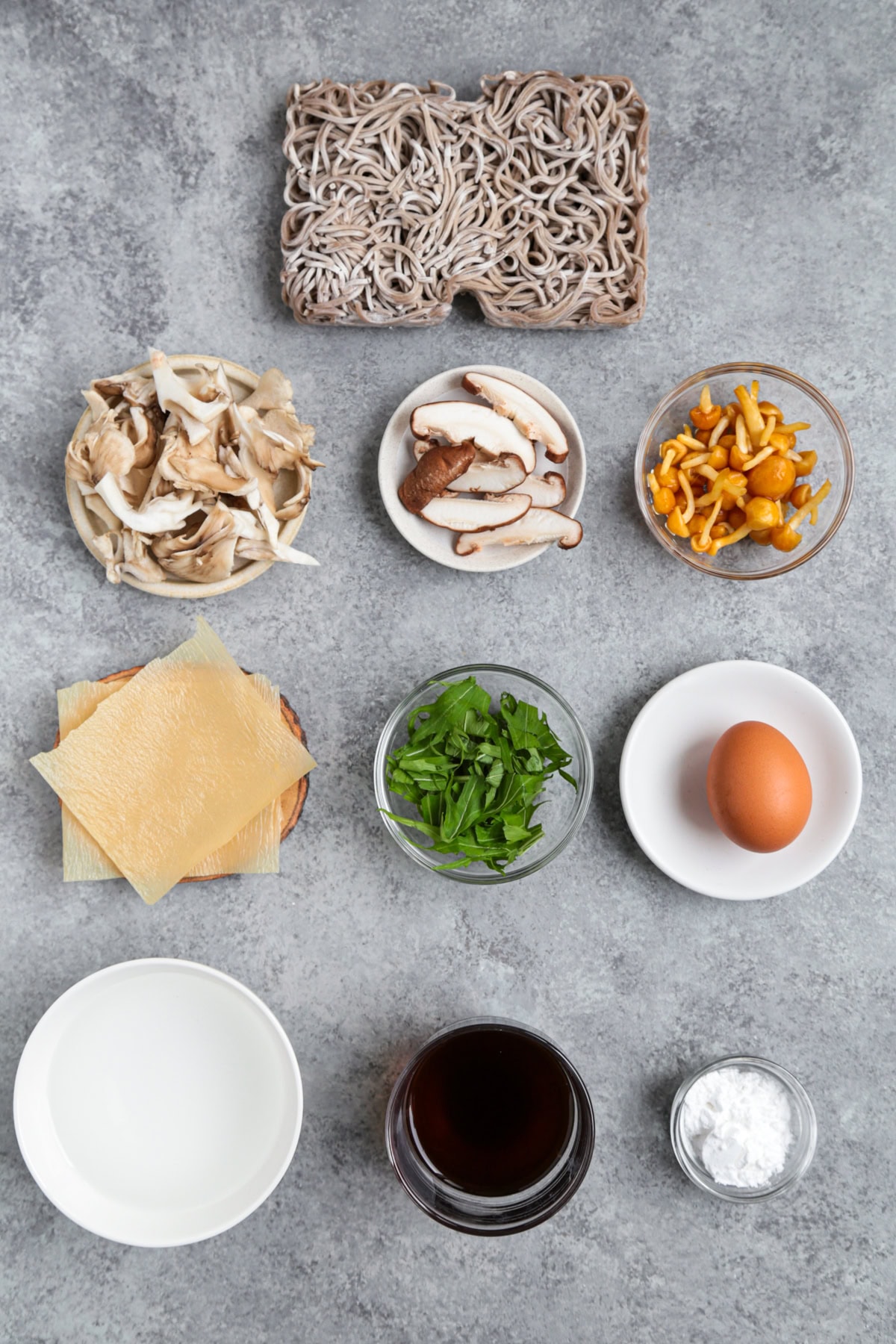
Ingredients Needed
- Yuba (optional): Yuba is dried tofu skin that comes in the form of thin sheets. Once rehydrated they have a rubbery texture and taste of soy milk (the flavor is very mild). Yuba can be found in Asian supermarkets or purchased here.
- Tsuyu: Tsuyu is the broth used to flavor the soup. It’s usually made with kombu, soy sauce, mirin, sake, and dashi (or bonito flakes). For this recipe I am using premade concentrated tsuyu, but you’d like to make it from scratch, click here for my homemade tsuyu recipe.
- Mushrooms: A mixture of maitake mushrooms, shiitake mushrooms, and nameko mushrooms. If you cannot find maitake and/or nameko mushrooms, replace them with other mushrooms such as oyster mushrooms, beech mushrooms, or enoki mushrooms.
- Soba noodles: Soba noodles are made from buckwheat and have a chewy and firm texture. The darker (more grey) they are and the higher the concentration in buckwheat. I personally like my soba to be very grey because the noodles are more solid and have a definite buckwheat taste. Frozen or dried soba noodles can be used for this recipe.
- Egg: 1 large egg is whisked and added to thicken the soup and make the dish more filling.
- Potato starch: Potato starch, called katakuriko, is an ingredient similar to cornstarch. It’s often used in Japanese cooking to thicken sauces, soups, and stews. Feel free to use cornstarch if you already happen to have some in your pantry as they are interchangeable.
- Mitsuba: Mitsuba, or Japanese parsley, is a plant that’s used as a topping for soups, hot pots (nabe), noodle dishes, and also added to salads. Its flavor is very refreshing and similar to flat parsley, cilantro, and celery leaf. Use any of these alternatives if you cannot find it.
- Hana fu (optional): The word hana fu simply means flower (hana) shaped fu, which is made of wheat gluten. Fu is very high in protein but doesn’t have any flavor. It’s used in buddhist cuisine (shojin) because it’s vegan, and also used in other types of Japanese cuisines, in various forms. For this dish, the fu is only used as garnish and is therefore optional.
- Ichimi togarashi (optional): Ichimi togarashi is a Japanese seasoning made of ground red chili pepper. It’s used to add a little heat and smokiness to noodle dishes, rice dishes, soups, yakitori, and other grilled meats.
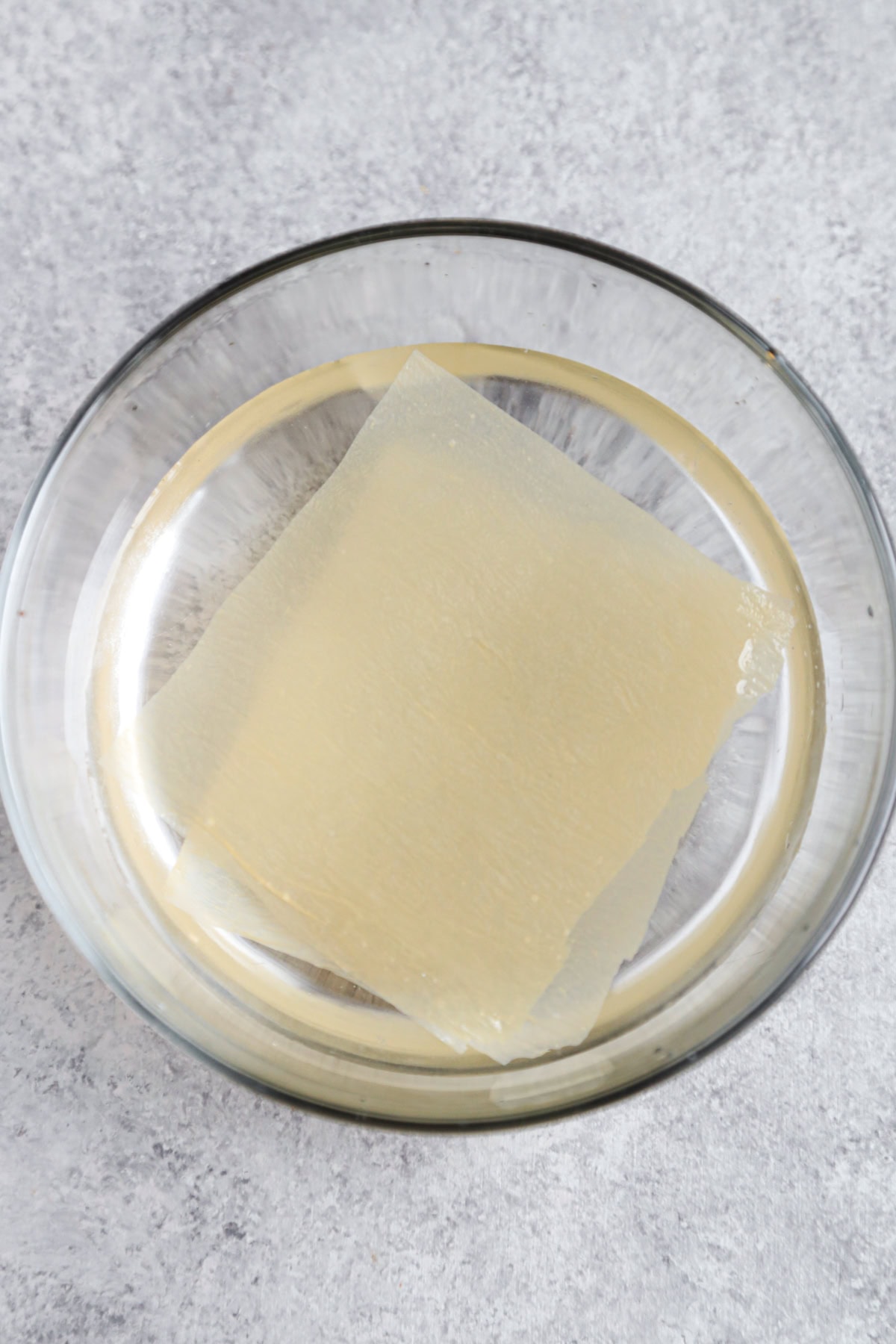
How To Make It
Scroll down to the recipe card for the full recipe.
- Rehydrate the yuba sheet by placing it in a bowl of cold water. Leave it there for a few minutes and gently take it out. Dry it with a paper towel, roll the sheet and slice it into 4 pieces.
- Make the soup by combining the water, tsuyu, maitake mushrooms, shiitake mushrooms, and nameko mushrooms. Bring the mixture to a boil and lower the heat. Simmer for 5 minutes.
- Boil and drain the soba noodles.
- Return to the soup and slowly add the whisked egg using chopsticks and moving them in a zigzag motion.
- Mix the potato starch slurry and stir it into the soup.
- Put the dish together and top with yuba, mitsuba, and hana fu. Serve with ichimi togarashi and slurp right away.
Expert Cooking Tip
Slightly undercook the noodles: When making noodle soups, it’s always a good idea to undercook the noodles a little so they don’t end up mushy after a few minutes of sitting in hot soup. When I say slightly I mean to undercook them by about 1 minute, nothing too drastic.
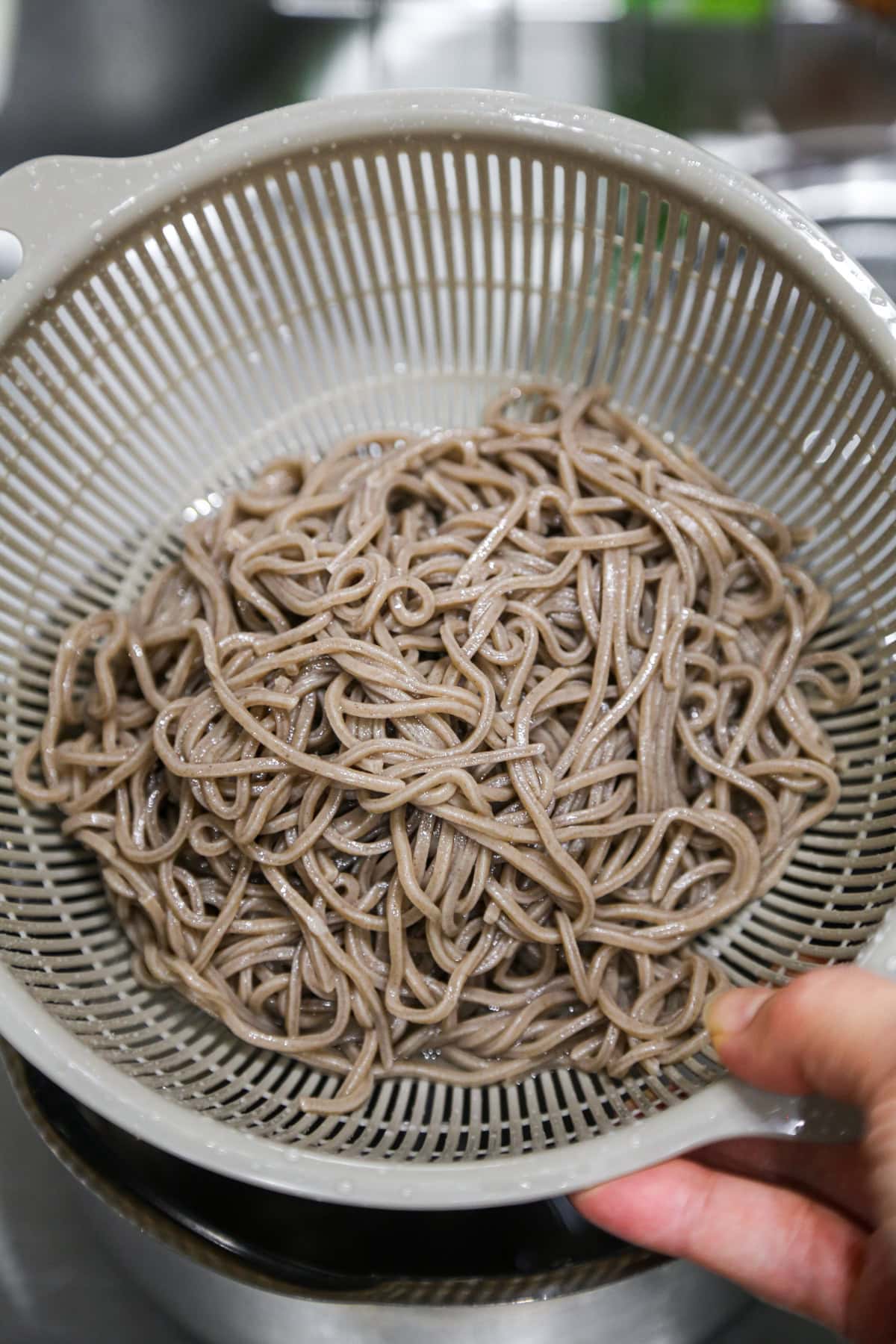
Frequently Asked Questions
Yes you can but I recommend that you give them a quick fry in the pan before adding them to the noodles. This will improve their texture and make them more meaty.
Yes you can! All you need to do is omit the egg and use a vegan premade tsuyu.
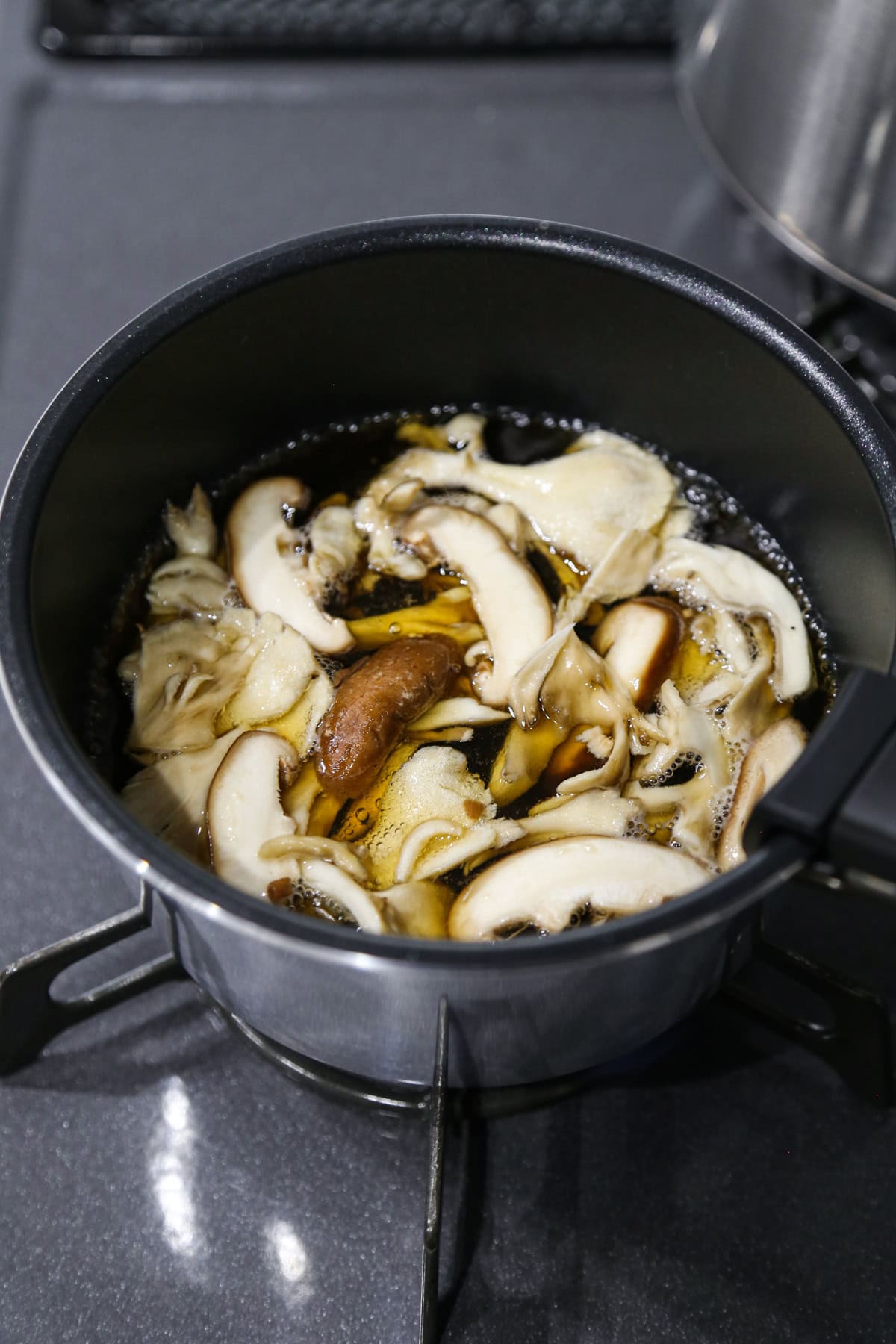
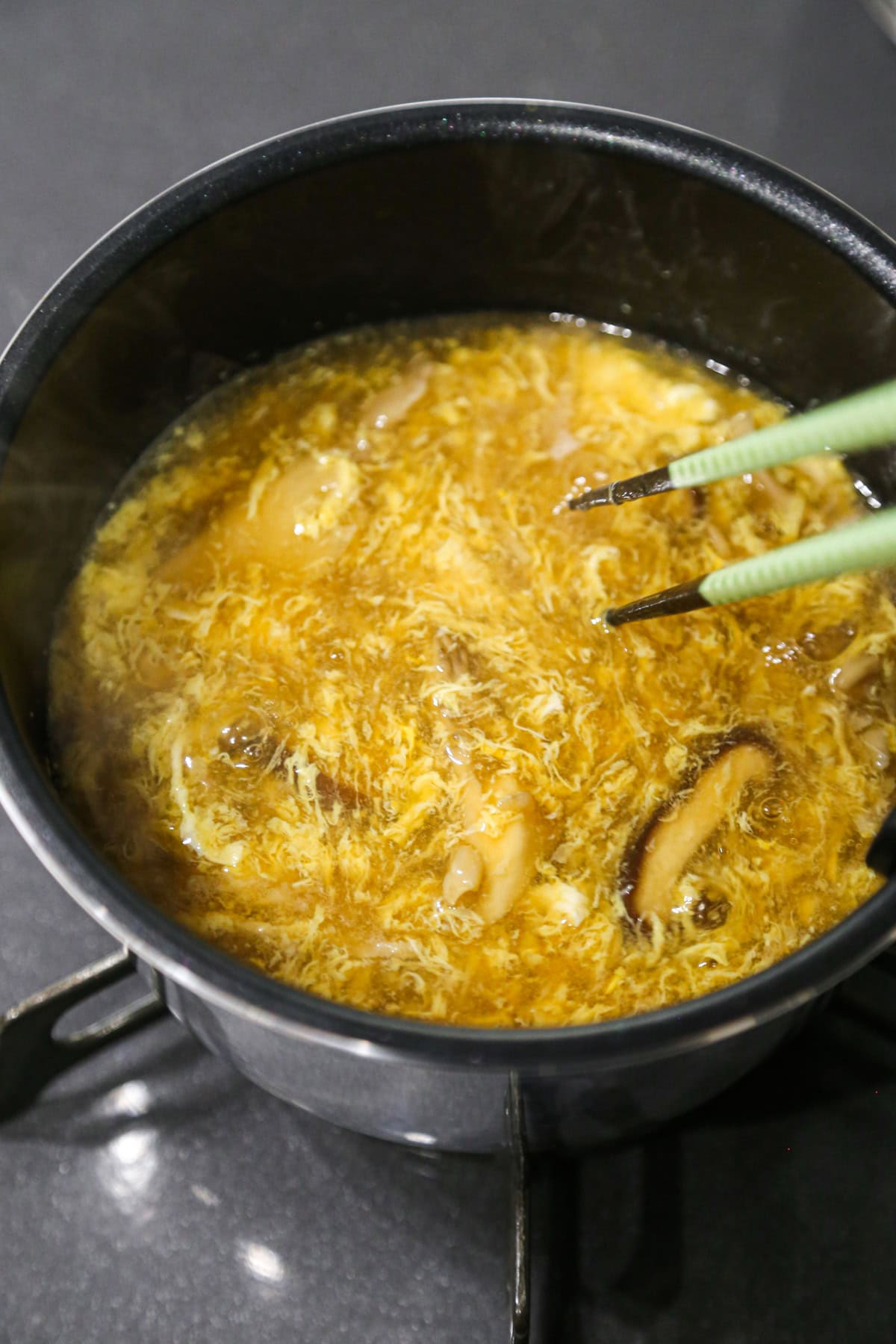
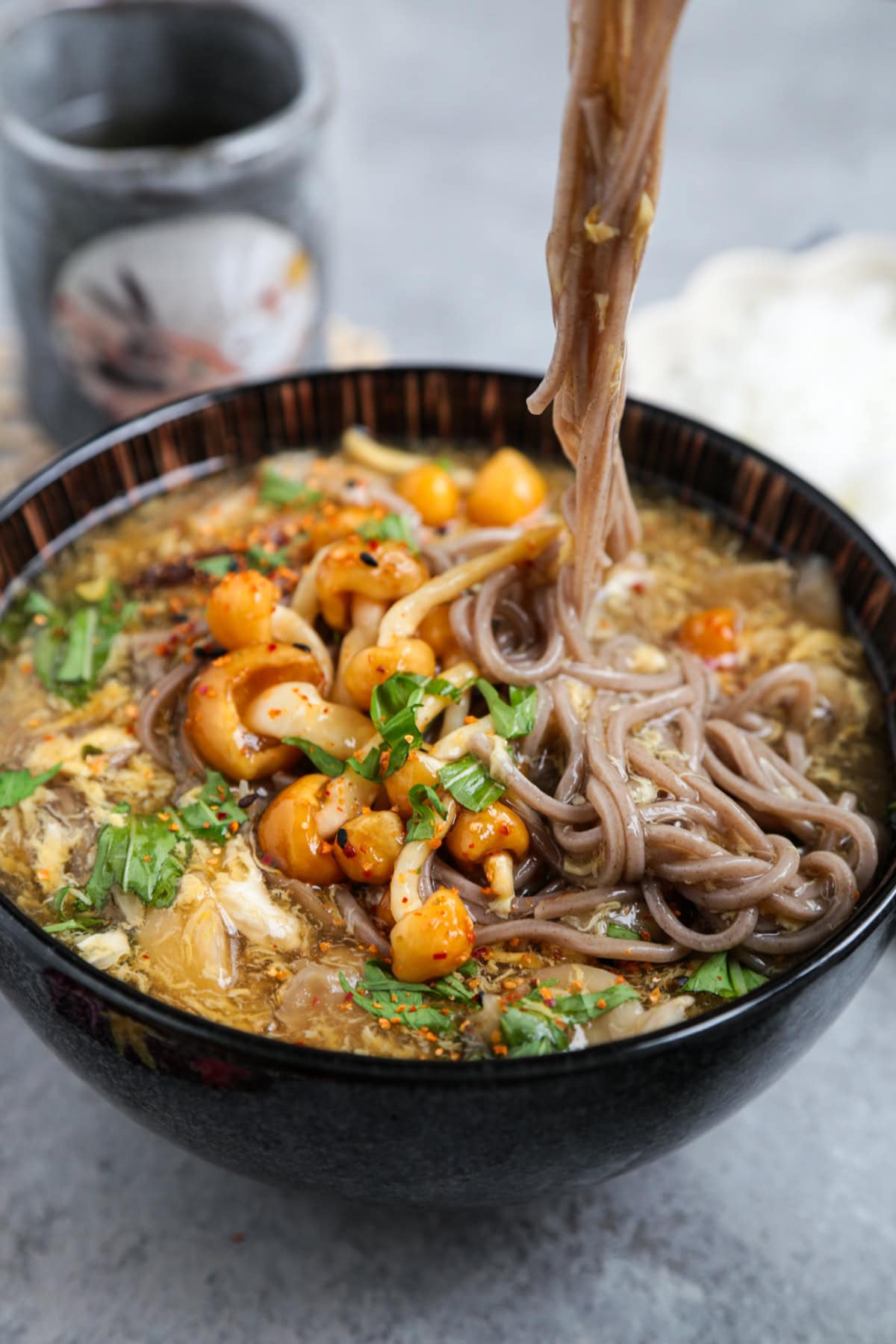
What To Serve This Dish With
While a bowl of soba is usually considered to be a light meal, this particular one happens to be quite filling! The addition of mushrooms and egg make it a fairly rounded meal that doesn’t need to be served with a lot of sides. However, if you are like my husband who always enjoys having more than just one dish in front of him, here are some sides that pair nicely with this soba recipe:
- Vegan kimchi
- Nasu dengaku (broiled miso glazed eggplant)
- Gomae (Japanese spinach salad with sesame sauce)
- Iceberg salad with carrot ginger dressing
- Inari sushi
- Hamachi crudo
Other noodle dishes you might like to try: Toshikoshi soba, zaru soba, naengmyeon (Korean cold soba noodles), soba noodle salad, miso ramen, shoyu ramen, spicy tsukemen, ginger and dashi tsukemen, vegetable champon, curry udon, bukkake udon, kitsune udon, yaki udon.
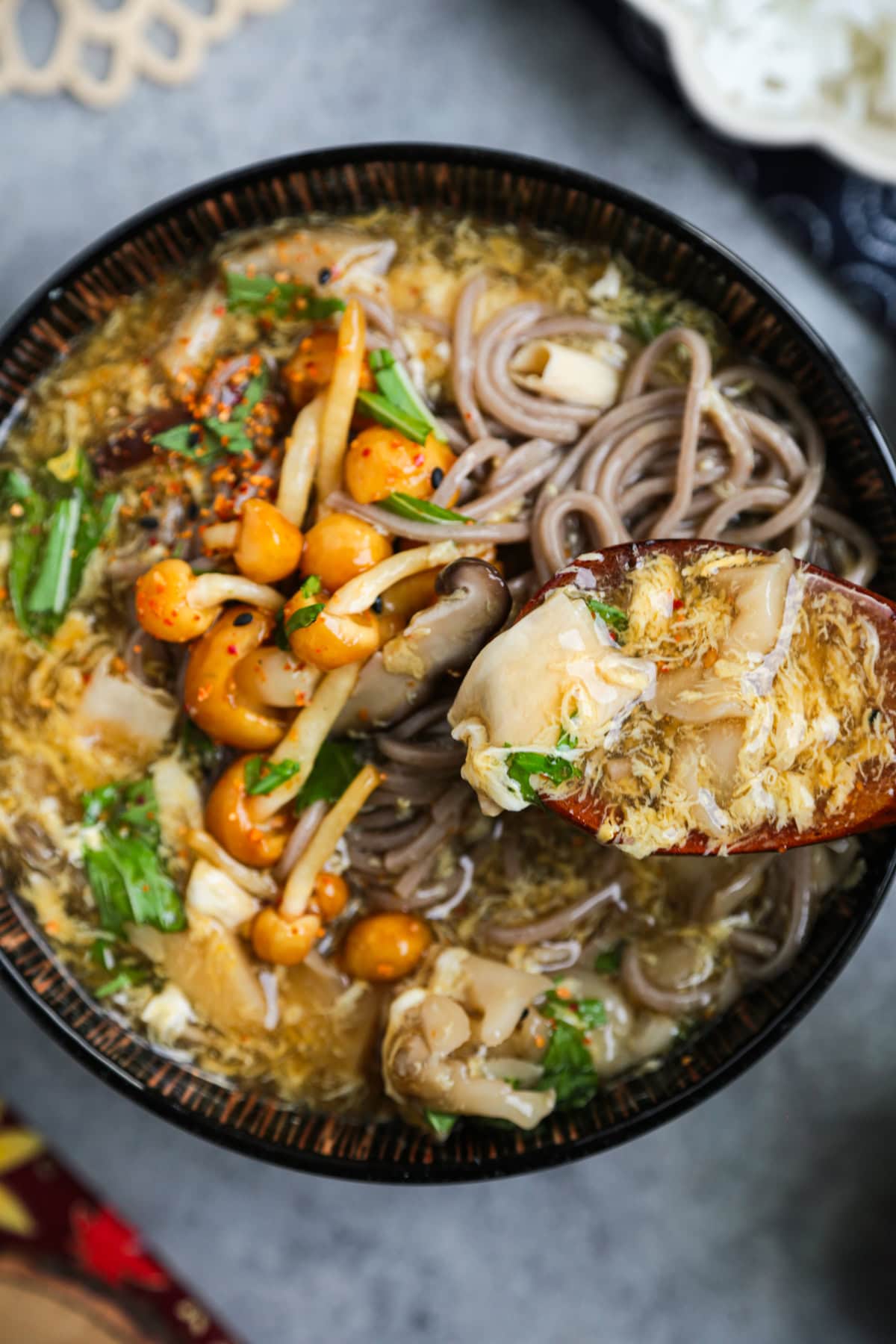
Did you like this recipe? Are there changes you made that you would like to share? Share your tips and recommendations in the comments section below!
Print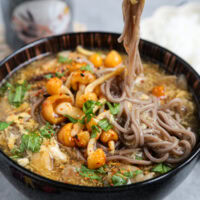
Soba Ankake With Mushroom, Yuba And Egg
- Prep Time: 5 minutes
- Cook Time: 10 minutes
- Total Time: 15 minutes
- Yield: 1 serving 1x
- Category: Noodles
- Method: Boiling
- Cuisine: Japanese
- Diet: Vegetarian
Description
A comforting bowl of soba noodles served in a gooey and eggy broth packed with mushrooms.
Ingredients
- 1 sheet yuba or 1 sheet aburage (deep fried tofu)
- 300ml water
- 100ml tsuyu
- 1/2 cup maitake mushrooms, chopped bite size
- 1 shiitake mushroom, stem removed and sliced into strips
- 1/4 cup nameko mushrooms or 1/4 cup shimeji mushrooms (white beech mushrooms), or use 1 extra shiitake mushroom
- 1 package fresh or frozen soba noodles (about 4 ounces), or 2 ounces dried soba noodles
- 1 egg, whisked
- 3 teaspoons potato starch or cornstarch, mixed with 2 tablespoons cold water
- A few leaves mizuna, mitsuba, or flat leaf parsley, finely chopped
- 4 or 5 hana fu, optional
- Ichimi (ground red chili pepper), optional
Instructions
- Soak the yuba sheet: Fill a bowl with water and add the yuba sheet. Leave for 2 to 3 minutes or until the yuba is soft. If you are using aburaage, soak it in water for 1 to 2 minutes.
- Slice the yuba sheet: Take the yuba sheet out of the water, roll it up and slice into 1-inch pieces. Set aside. For aburaage, take it out of the water and squeeze to remove excess water. Slice into 1-inch pieces and set aside.
- Make the sauce: Place the water, tsuyu, maitake mushrooms, shiitake mushroom and nameko, and bring to a boil. Turn the heat down and simmer for 5 minutes.
- Cook the soba noodles: Meanwhile, fill another pot with water and bring to a boil. Add the soba noodles and cook for 2 to 3 minutes, or according to the directions on the package.
- Drain them: Drain the noodles and transfer them to a serving bowl.
- Add the potato starch slurry: Give the cornstarch slurry a quick stir. Make sure the cornstarch has completely dissolved in the water before adding it to the soup, otherwise it will turn into clumps. Add the cornstarch slurry to the soup while constantly stirring. Keep stirring until the soup thickens and is gooey.
- Slowly add the egg: Add a third of the whisked egg into the soup and slowly stir in a zigzag motion using chopsticks.This motion breaks the eggs and gives them their flower/teardrop shape. Repeat this step 2 more times until the entire egg is used.
- Add the sauce to the soba noodles: Turn the heat off and pour the soup over the soba noodles.
- Add the garnishes and serve: Top with mizuna, hana fu and yuba. Serve with ichimi.
Notes
This recipe tastes best when served immediately. It doesn’t keep well as the noodles get mushy the longer they stay in the broth.
Nutrition
- Serving Size: 1 serving
- Calories: 352
- Sugar: 1.7g
- Sodium: 538mg
- Fat: 5.4g
- Saturated Fat: 1.7g
- Unsaturated Fat: 1.1g
- Trans Fat: 0g
- Carbohydrates: 54.4g
- Fiber: 1.7g
- Protein: 16.1g
- Cholesterol: 186mg
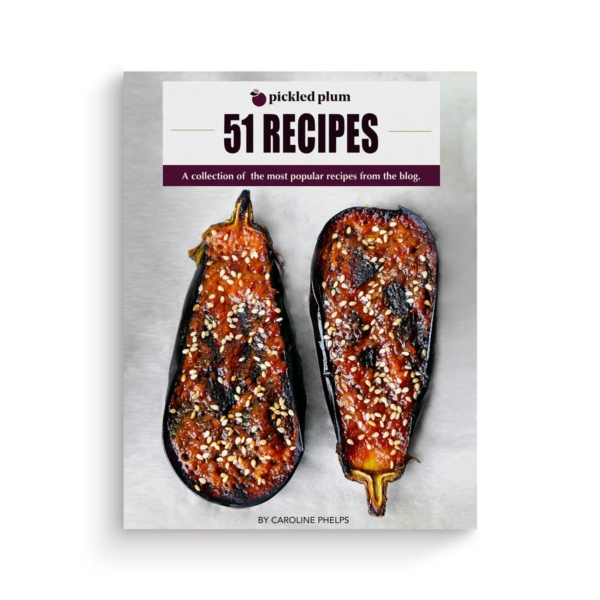
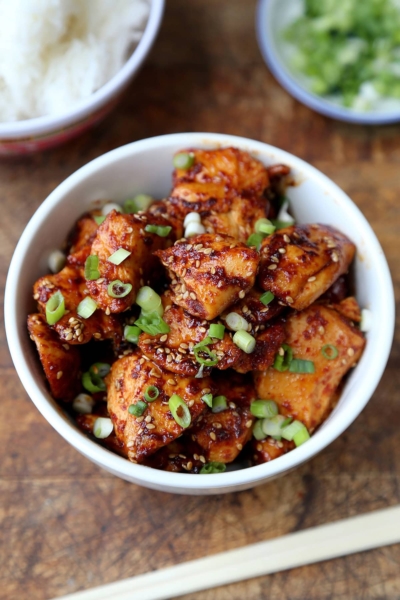
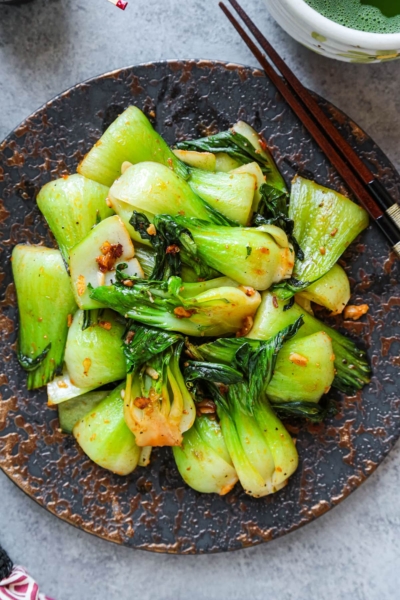
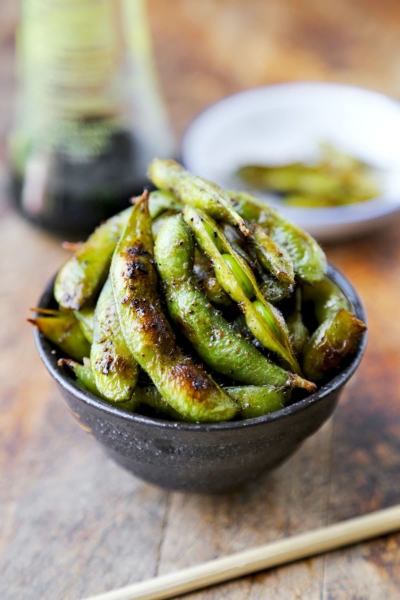
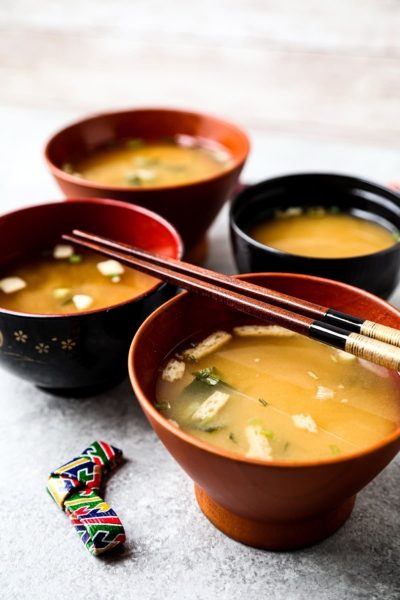
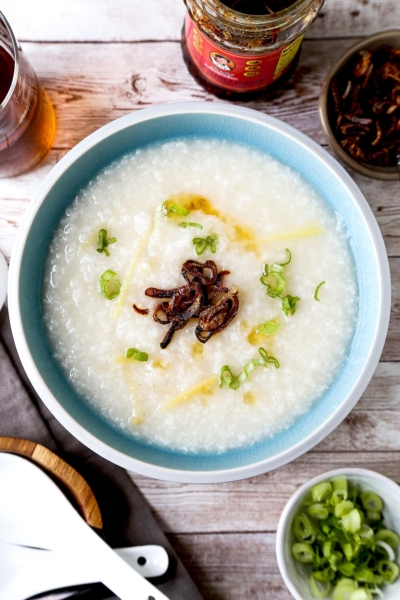
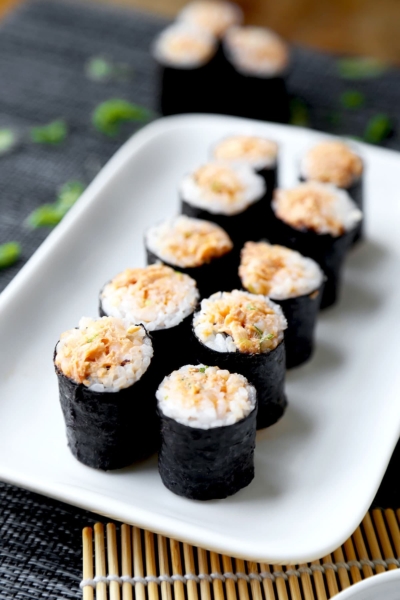








Did you find a substitute for the yuba? There are so many kinds of soy products, I am sure that something else that is more easily available could substitute. What about the hana fu? Is it only the shape that is different from what you used? This soup looks very easy!
Hi Alice! Yes, the substitutes are written in the recipe card 🙂 The hana fu is optional but I was able to find it on Amazon and added a link in the Ingredients Needed section. The one I had at the restaurant had an almost mochi-like texture. The one in the video wasn’t like that and I felt like it didn’t really go with the dish. It was more like actual fu which has the texture of soaked bread.